Genus Leucauge (Silver Marsh Spider, Silver Vlei Spider)
A diurnal spider, resembling a small version of Nephila but has no tibial brushes on the legs. The cephalothorax (head and thorax) and legs are a plastic green in appearance while the elongated abdomen is silver with green infusions while some species have yellow and red markings as well. Eight species of this pantropical genus are recorded from South Africa. Leucauge is derived from Greek "leukos" means "white"). The horizontal to vertically inclined (45%) web is situated amongst low vegetation, usually about 500 mm or lower, often in association with damp vlei seepages in all habitats.
Lifestyle
Web dwellers (orb-web): the webs are mostly built in vegetation near water; abundance: rare.
Body size
6-18 mm (males only slightly smaller, chelicerae in male with strong spurs).
Diagnostic characters
Colour: carapace brownish with abdomen bright silver distinctly decorated with green, white, red and bronze patterns.
Carapace: longer than wide.
Eyes: 8 eyes in 2 evenly spaced rows.
Chelicerae: variable: short and thick and sometimes with strong large teeth and strong projecting spurs, which are strongly en-larged in males.
Abdomen: variable from elongate and cylindrical in some species extending caudally past spinnerets, to round or ovoid.
Legs: 3 claws, legs long and slender with posterior femora with double fringe of trichobothria on prolateral surface of basal half.
Web and retreat
Web: large, complete orb-webs; the inclination of the webs varies from vertical to horizontal, and is most often at a sharp angle to vertical. The hub is open, with clear, widely spaced viscous spirals (15-30).
Rretreat: absent
Habitat
They are more commonly found in wet grassland, in vleis and marshes and humid forests.
Behaviour
Leucauge species spin their large orb-webs in the morning or during the day and sometimes re-use the frame and anchor lines. They are diurnal and commonly seen during the day.
Prey
A variety of flying insects.
AW Arachnid Book: Spiders (Araneae) - Photos & Descriptions
Moderator: Klipspringer
AW Arachnid Book: Spiders (Araneae) - Photos & Descriptions
Silver Marsh Spider, Silver Vlei Spider Leucauge sp.
Family Tetragnathidae
Three different individuals:
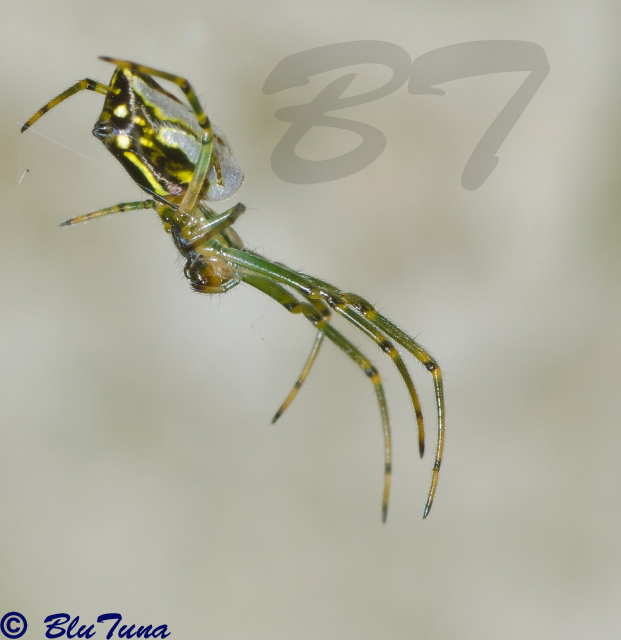
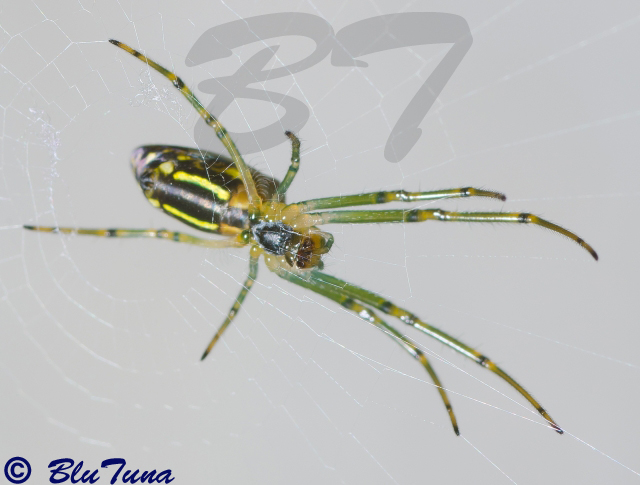
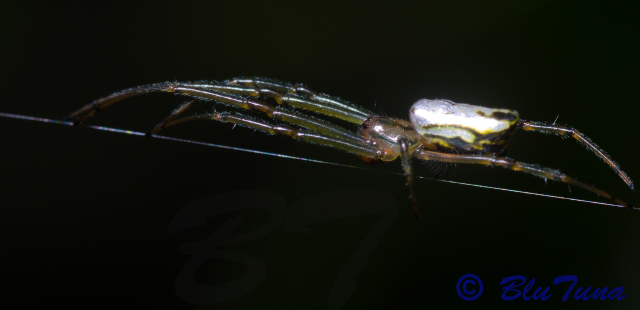
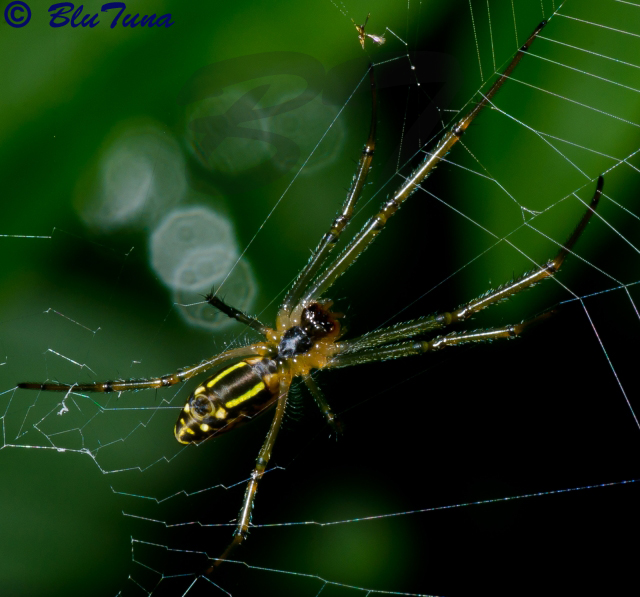
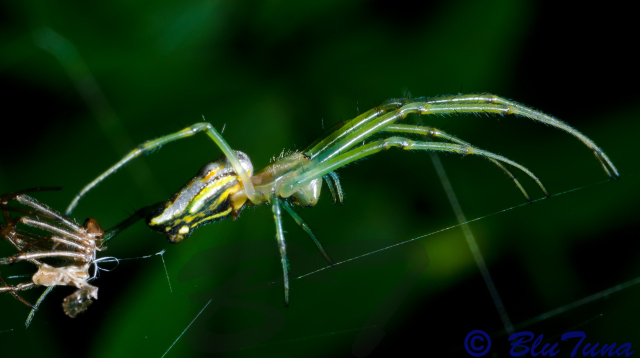
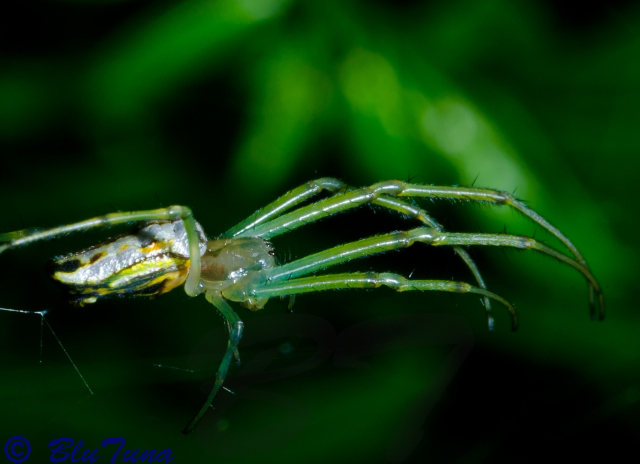
Garden in Johannesburg
https://books.google.de/books?id=RKs_Dw ... de&f=false
Family Tetragnathidae
Three different individuals:






Garden in Johannesburg
https://books.google.de/books?id=RKs_Dw ... de&f=false
Hunting cannot be considered a sport as all contestants in a sport should know they are playing the game!
Araneomorphae, Theriidae
Family Theridiidae
The Theridiidae (Cob-web or Comb-footed Spiders) is a large cosmopolitan family of spiders represented by 62 genera and more than 2000 species. The family is represented by 15 genera in South Africa. They are nocturnal, web-living spiders. The females vary from 7-16 mm body length and the males 2.5-5 mm. Females all have the typical spherical-shaped abdomen and long, slender legs.
Life style
Web builders (gumfoot-webs): three dimensional aerial webs made in dark corners in a variety of micro-habitats.
Body size
2-15 mm (males usually much smaller than female, frequently sexual dimorphism in shape and colour).
Diagnostic characters
Colour: body colour variable from greyish brown to pitch black to bright yellow; many species are cryptic.
Carapace: variable in profile from flat to high, in some genera males with frontal region of carapace with extravagant modifications.
Eyes: 8 in 2 rows.
Abdomen: variable in shape from oval to round and high to very long, sometimes extending past spinnerets, some species with dorsal stridulating plates near pedicel.
Legs: moderately to very long, with no or few spines, no spines on the tibiae and metatarsi, tarsi usually tapering and tarsus IV with a row of slightly curved serrated setae composing a comb.
Web and retreat
Web: most genera construct three-dimensional gumfoot-webs.
Retreat: some build special retreats inside or outside the frame using plant material or soil particles to hide beneath.
Habitat
The theridiids are a diverse group of spiders and found in all the different biomes in a variety of habitats e.g. on plants, on tree trunks, in the crevices of rocks and walls under stones and under a variety of structures in and around houses. A few species are web-less and run on the ground.
Behaviour
Theridiid spiders have very diverse life styles and the structure of their webs vary between genera and are made in a variety of micro-habitats. In most of the smaller ground-living species the lower catch threads are attached under high tension to the ground and are studded with sticky droplets. When pedestrian prey collide with these threads, which dislodge readily, they stick t he droplets and end up swinging helpless while being lifted from the substrate by the spider. The theridiids wrap attack is unique in that viscid silk, and not dry silk is thrown over the prey from some distance with the help of the comb of setae on tarsi IV. In some genera the web is reduced or has been lost.
The most common genera indigenous to southern Africa are:
Latrodectus (button spiders, widow spiders)
This is a notorious genus in that certain species are highly toxic and, under rare circumstances, can kill people if they are bitten. There are 6 species in South Africa, 5 of which occur in the Western Cape. The very common species, Latrodectus geometricus, or Brown or Geometric button spider occurs around every home but fortunately a bite from this species is not life threatening. On the other hand, Latrodectus indistinctus, or the Black button spider presents a serious problem. Its venom is neurotoxic (affects the central nervous system). This spider does not occur around the Cape Peninsula but distribution starts from about Bellville and extends north and east.
Steatoda (false button spiders)
Colour ranges from brown to black with a white to yellow crescent marking on the anteriodorsal (front top) side of the abdomen. These spiders are harmless to man and occur under stones and bark or hollows in walls and are sometimes found in the home. Certain colour forms can be mistaken for true button spiders.
Several spider species produce neurotoxic venom but in southern Africa the button spiders (elsewhere in the world known as widow spiders) are the most important group of medical importance. Six species occur here, belonging to the genus Latrodectus of the family Theridiidae. The button spiders can be divided into the black button spider complex (4 species.) and the brown button spider complex (2 species.).
The button spiders have round abdomens with slender legs of which the third pair of legs is the shortest. Their colour varies from cream to pitch black between species. The markings on the abdomen also vary from stripes to spots. In adult females the markings become less distinct. The patterns on the ventral side of the abdomen vary from having none to one with a distinct red hourglass pattern. Males are much smaller than females and the markings on their abdomen consist of red or white bands.
The female constructs her web, which contains a funnel-shape retreat on one side, usually close to the ground in bushes or under debris. The egg sacs are creamy-white and vary in shape from round and smooth to fluffy or spiky.
The female frequently kills the male after mating, hence the common name "widow spiders". The female produces more than one egg sac per season usually during the summer months. The egg sacs are attached with silk to the side of the web. The spiderlings hatch after a week or more and one egg sac can contains more than 100 spiders. They disperse by wind and construct their own webs. They undergo between 7-9 moults before reaching adulthood and can live between 12-18 months. They feed on a variety of insects such as beetles and termites.
The black button spider complex contains the following four species: Latrodectus cinctus, L. indistinctus, L. karooensis and L. renivulvatus and they are regarded as the more venomous group. Although no documented records exist of fatality due to black button spider bites, they have the potential to cause severe symptoms with small children and elderly people being at greatest risk.
The black button spiders are black with red patterns on top of the body. The markings vary between species from stripes to spots. In adult females the markings become less distinct. There are no markings on the ventral side of the abdomen in adults. The egg sacs in all four species are creamy-white, round and smooth.
The black buttons are widely distributed throughout South Africa and are more often found in natural habitats then in built-up areas. The four black button species have the following distribution pattern:
L. cinctus (east coast button spider) is found in the eastern parts of South Africa (KwaZulu-Natal, Eastern Cape).
L. indistinctus (west coast button spider) is commonly found on the west coast of the Western Cape Province.
L. karooensis (karoo button spider) is a species found only in the karoo.
L. renivulvatus (inland button spider) is an inland species found in the central parts of South Africa.
The brown button spider complex contains two species and they are regarded as less venomous: L. geometricus and L. rhodesiensis. They are very similar in appearance to the black buttons but their colour varies from cream, grey and brown to pitch black. The ventral surface of the abdomen in both species has a prominent red to orange hourglass marking, while the dorsal surface is covered with an intricate geometrical pattern in the paler specimens. A potential source of confusion with respect to the identification of these two species is that the most venomous species in Europe and America have the same red hourglass pattern as the two less venomous species found here.
Latrodectus geometricus is an introduced species and very common in Southern Africa and is usually found in built-up areas, especially around houses and outbuildings. They construct a funnel-shape retreat in dark corners with silk threads radiating outwards. The egg sac is characteristic in having a spiky appearance.
Latrodectus rhodesiensis was originally described from Zimbabwe. They are usually paler in colour and their egg sacs are distinct in being larger and having a more fluffy appearance. They have been recorded from Zimbabwe and also small areas in Gauteng, Mpumalanga and the Limpopo Province.
Symptoms of Latrodectism: only the female button spider is able to pierce the skin in humans, and in most cases the potential full dosage of venom is not administered. The term latrodectism is used to describe the symptoms and signs caused by envenomation of the button spiders. The black button complex causes a more severe form of envenomation than the brown button spiders.
Black button spiders: the bite of a black button spider is usually very painful and causes profuse sweating, raised blood pressure and restlessness and generalised muscle pain and cramps, stiffness of the stomach muscles, limb pain especially legs, weakness in legs. Although no documented records exist of fatality due to button spider bites, they have the potential to cause severe symptoms with small children and elderly people being at greatest risk.
Brown button spiders: the symptoms occurring after a bite from one of the brown buttons are milder and tend to be restricted to the bite site, characterized by a local burning sensation, which may spread to the surrounding tissue and lymph nodes. The bite site is more evident and often seen as a red macular spot or blanched area surrounded by a localised rash. The condition usually clears up within a day or two.
The Theridiidae (Cob-web or Comb-footed Spiders) is a large cosmopolitan family of spiders represented by 62 genera and more than 2000 species. The family is represented by 15 genera in South Africa. They are nocturnal, web-living spiders. The females vary from 7-16 mm body length and the males 2.5-5 mm. Females all have the typical spherical-shaped abdomen and long, slender legs.
Life style
Web builders (gumfoot-webs): three dimensional aerial webs made in dark corners in a variety of micro-habitats.
Body size
2-15 mm (males usually much smaller than female, frequently sexual dimorphism in shape and colour).
Diagnostic characters
Colour: body colour variable from greyish brown to pitch black to bright yellow; many species are cryptic.
Carapace: variable in profile from flat to high, in some genera males with frontal region of carapace with extravagant modifications.
Eyes: 8 in 2 rows.
Abdomen: variable in shape from oval to round and high to very long, sometimes extending past spinnerets, some species with dorsal stridulating plates near pedicel.
Legs: moderately to very long, with no or few spines, no spines on the tibiae and metatarsi, tarsi usually tapering and tarsus IV with a row of slightly curved serrated setae composing a comb.
Web and retreat
Web: most genera construct three-dimensional gumfoot-webs.
Retreat: some build special retreats inside or outside the frame using plant material or soil particles to hide beneath.
Habitat
The theridiids are a diverse group of spiders and found in all the different biomes in a variety of habitats e.g. on plants, on tree trunks, in the crevices of rocks and walls under stones and under a variety of structures in and around houses. A few species are web-less and run on the ground.
Behaviour
Theridiid spiders have very diverse life styles and the structure of their webs vary between genera and are made in a variety of micro-habitats. In most of the smaller ground-living species the lower catch threads are attached under high tension to the ground and are studded with sticky droplets. When pedestrian prey collide with these threads, which dislodge readily, they stick t he droplets and end up swinging helpless while being lifted from the substrate by the spider. The theridiids wrap attack is unique in that viscid silk, and not dry silk is thrown over the prey from some distance with the help of the comb of setae on tarsi IV. In some genera the web is reduced or has been lost.
The most common genera indigenous to southern Africa are:
Latrodectus (button spiders, widow spiders)
This is a notorious genus in that certain species are highly toxic and, under rare circumstances, can kill people if they are bitten. There are 6 species in South Africa, 5 of which occur in the Western Cape. The very common species, Latrodectus geometricus, or Brown or Geometric button spider occurs around every home but fortunately a bite from this species is not life threatening. On the other hand, Latrodectus indistinctus, or the Black button spider presents a serious problem. Its venom is neurotoxic (affects the central nervous system). This spider does not occur around the Cape Peninsula but distribution starts from about Bellville and extends north and east.
Steatoda (false button spiders)
Colour ranges from brown to black with a white to yellow crescent marking on the anteriodorsal (front top) side of the abdomen. These spiders are harmless to man and occur under stones and bark or hollows in walls and are sometimes found in the home. Certain colour forms can be mistaken for true button spiders.
Several spider species produce neurotoxic venom but in southern Africa the button spiders (elsewhere in the world known as widow spiders) are the most important group of medical importance. Six species occur here, belonging to the genus Latrodectus of the family Theridiidae. The button spiders can be divided into the black button spider complex (4 species.) and the brown button spider complex (2 species.).
The button spiders have round abdomens with slender legs of which the third pair of legs is the shortest. Their colour varies from cream to pitch black between species. The markings on the abdomen also vary from stripes to spots. In adult females the markings become less distinct. The patterns on the ventral side of the abdomen vary from having none to one with a distinct red hourglass pattern. Males are much smaller than females and the markings on their abdomen consist of red or white bands.
The female constructs her web, which contains a funnel-shape retreat on one side, usually close to the ground in bushes or under debris. The egg sacs are creamy-white and vary in shape from round and smooth to fluffy or spiky.
The female frequently kills the male after mating, hence the common name "widow spiders". The female produces more than one egg sac per season usually during the summer months. The egg sacs are attached with silk to the side of the web. The spiderlings hatch after a week or more and one egg sac can contains more than 100 spiders. They disperse by wind and construct their own webs. They undergo between 7-9 moults before reaching adulthood and can live between 12-18 months. They feed on a variety of insects such as beetles and termites.
The black button spider complex contains the following four species: Latrodectus cinctus, L. indistinctus, L. karooensis and L. renivulvatus and they are regarded as the more venomous group. Although no documented records exist of fatality due to black button spider bites, they have the potential to cause severe symptoms with small children and elderly people being at greatest risk.
The black button spiders are black with red patterns on top of the body. The markings vary between species from stripes to spots. In adult females the markings become less distinct. There are no markings on the ventral side of the abdomen in adults. The egg sacs in all four species are creamy-white, round and smooth.
The black buttons are widely distributed throughout South Africa and are more often found in natural habitats then in built-up areas. The four black button species have the following distribution pattern:
L. cinctus (east coast button spider) is found in the eastern parts of South Africa (KwaZulu-Natal, Eastern Cape).
L. indistinctus (west coast button spider) is commonly found on the west coast of the Western Cape Province.
L. karooensis (karoo button spider) is a species found only in the karoo.
L. renivulvatus (inland button spider) is an inland species found in the central parts of South Africa.
The brown button spider complex contains two species and they are regarded as less venomous: L. geometricus and L. rhodesiensis. They are very similar in appearance to the black buttons but their colour varies from cream, grey and brown to pitch black. The ventral surface of the abdomen in both species has a prominent red to orange hourglass marking, while the dorsal surface is covered with an intricate geometrical pattern in the paler specimens. A potential source of confusion with respect to the identification of these two species is that the most venomous species in Europe and America have the same red hourglass pattern as the two less venomous species found here.
Latrodectus geometricus is an introduced species and very common in Southern Africa and is usually found in built-up areas, especially around houses and outbuildings. They construct a funnel-shape retreat in dark corners with silk threads radiating outwards. The egg sac is characteristic in having a spiky appearance.
Latrodectus rhodesiensis was originally described from Zimbabwe. They are usually paler in colour and their egg sacs are distinct in being larger and having a more fluffy appearance. They have been recorded from Zimbabwe and also small areas in Gauteng, Mpumalanga and the Limpopo Province.
Symptoms of Latrodectism: only the female button spider is able to pierce the skin in humans, and in most cases the potential full dosage of venom is not administered. The term latrodectism is used to describe the symptoms and signs caused by envenomation of the button spiders. The black button complex causes a more severe form of envenomation than the brown button spiders.
Black button spiders: the bite of a black button spider is usually very painful and causes profuse sweating, raised blood pressure and restlessness and generalised muscle pain and cramps, stiffness of the stomach muscles, limb pain especially legs, weakness in legs. Although no documented records exist of fatality due to button spider bites, they have the potential to cause severe symptoms with small children and elderly people being at greatest risk.
Brown button spiders: the symptoms occurring after a bite from one of the brown buttons are milder and tend to be restricted to the bite site, characterized by a local burning sensation, which may spread to the surrounding tissue and lymph nodes. The bite site is more evident and often seen as a red macular spot or blanched area surrounded by a localised rash. The condition usually clears up within a day or two.
AW Arachnid Book: Spiders (Araneae) - Photos & Descriptions
Brown Button Spider, Brown Widow, Geometric Button Spider Latrodectus geometricus
Superfamily: Araneoidea. Family: Theridiidae
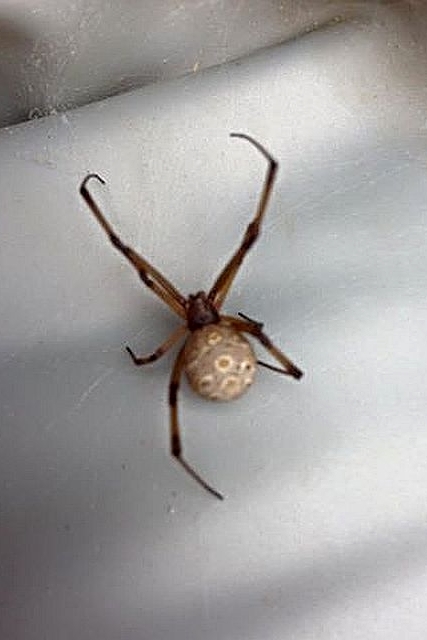 © Flutterby
© Flutterby
Garden in Johnnesburg
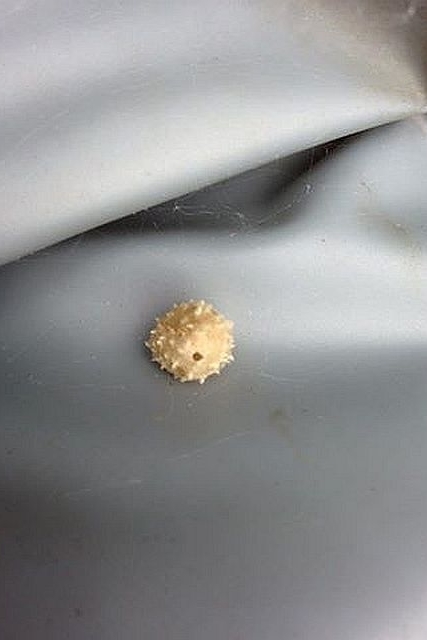 © Flutterby
© Flutterby
Egg sac
Description
7-10 mm. Brown Button spiders, despite their name, can be creamy white to very dark blackish brown. They have a red-orange double-isosceles-triangle marking under the abdomen (hourglass marking). Paler specimens have geometrical white to orange markings above with darker centres and borders. Legs long, tapered.
Males are very small and harmless to humans.
Distribution
Latrodectus geometricus is an introduced species and very common in Southern Africa and is usually found in built-up areas.
Habitat
Brown Button Spiders are common, widespread and often found in and around human habitation, especially around houses and outbuildings.
They construct a funnel-shape retreat in dark corners with silk threads radiating outwards. The egg sac is spherical and covered in little silken spikes.
Kruger National Park © ExFmem
Superfamily: Araneoidea. Family: Theridiidae
 © Flutterby
© FlutterbyGarden in Johnnesburg
 © Flutterby
© FlutterbyEgg sac
Description
7-10 mm. Brown Button spiders, despite their name, can be creamy white to very dark blackish brown. They have a red-orange double-isosceles-triangle marking under the abdomen (hourglass marking). Paler specimens have geometrical white to orange markings above with darker centres and borders. Legs long, tapered.
Males are very small and harmless to humans.
Distribution
Latrodectus geometricus is an introduced species and very common in Southern Africa and is usually found in built-up areas.
Habitat
Brown Button Spiders are common, widespread and often found in and around human habitation, especially around houses and outbuildings.
They construct a funnel-shape retreat in dark corners with silk threads radiating outwards. The egg sac is spherical and covered in little silken spikes.
Kruger National Park © ExFmem
AW Arachnid Book: Spiders (Araneae) - Photos & Descriptions
Theriid Button Spider, possibly a False Button Spider Steatoda sp.
Family Theridiidae
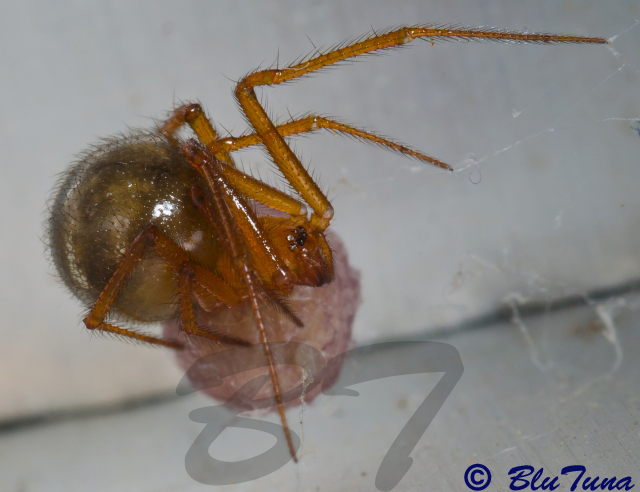
Johanesburg
Family Theridiidae

Johanesburg
Hunting cannot be considered a sport as all contestants in a sport should know they are playing the game!
Gnaphosidae
Family Gnaphosidae (Stealthy Ground Spiders, Wandering Spiders, Flat-bellied Ground Spiders)
The family Gnaphosidae is a large family and comprises an estimated 141 genera and about 1500 species widely distributed throughout the world. Fourty-three genera and about 320 species occur in the Afrotropical Region and 27 genera and about 195 species are known from Southern Africa with 118 species being endemics.
Description (Gnaphosidae)
Body size: 3-17 mm (males slightly more slender).
Carapace: ovoid, smoothly convex and rather low, usually with distinct fovea.
Eyes: 8 small eyes arranged in 2 rows (4:4) with anterior eyes round, posterior median eyes flattened oval or irregularly shaped or round, eyes with silvery shine.
Abdomen: hairy and elongate to oval with cluster of erect curved setae present on anterior edge. In males an anterior scuta sometimes present.
Spinnerets: anterior spinnerets parallel, large, cylindrical and usually well separated.
Habitat
Gnaphosids are more commonly found in dry grassland and savanna regions.
Biology
Life style: Wanderers (ground dwellers); free- running.
Gnaphosids do not spin a web and spend the day in a silken retreat. They make a silken sac under stones and surface debris within which they live during non-active periods. Some gnaphosids attach their egg cocoon to the substrate while others make simple cocoons in their retreats or build more complicated egg cocoons. Egg cocoons can contain up to 250 eggs per sac.
Their eyesight is poor and prey is perceived by tactile or chemotactic stimuli. Generally Gnaphosids are nocturnal hunters and either catch their prey with speed, force and agility or rapidly enswath them with broad bands of silk, HOWEVER, members of the genus Micaria dart between detritus and stones in an ant-like fashion searching for prey during the day.
Some genera have been observed preying on ants. The ant is attacked head-on and the bite is delivered at the base of the antennae. The spider withdraws, and waits until the ant is paralyzed. The ant is then tucked underneath the spider's body and carried away from the other ants. A number of species also live in close association with harvester termites on which they prey.
The family Gnaphosidae is a large family and comprises an estimated 141 genera and about 1500 species widely distributed throughout the world. Fourty-three genera and about 320 species occur in the Afrotropical Region and 27 genera and about 195 species are known from Southern Africa with 118 species being endemics.
Description (Gnaphosidae)
Body size: 3-17 mm (males slightly more slender).
Carapace: ovoid, smoothly convex and rather low, usually with distinct fovea.
Eyes: 8 small eyes arranged in 2 rows (4:4) with anterior eyes round, posterior median eyes flattened oval or irregularly shaped or round, eyes with silvery shine.
Abdomen: hairy and elongate to oval with cluster of erect curved setae present on anterior edge. In males an anterior scuta sometimes present.
Spinnerets: anterior spinnerets parallel, large, cylindrical and usually well separated.
Habitat
Gnaphosids are more commonly found in dry grassland and savanna regions.
Biology
Life style: Wanderers (ground dwellers); free- running.
Gnaphosids do not spin a web and spend the day in a silken retreat. They make a silken sac under stones and surface debris within which they live during non-active periods. Some gnaphosids attach their egg cocoon to the substrate while others make simple cocoons in their retreats or build more complicated egg cocoons. Egg cocoons can contain up to 250 eggs per sac.
Their eyesight is poor and prey is perceived by tactile or chemotactic stimuli. Generally Gnaphosids are nocturnal hunters and either catch their prey with speed, force and agility or rapidly enswath them with broad bands of silk, HOWEVER, members of the genus Micaria dart between detritus and stones in an ant-like fashion searching for prey during the day.
Some genera have been observed preying on ants. The ant is attacked head-on and the bite is delivered at the base of the antennae. The spider withdraws, and waits until the ant is paralyzed. The ant is then tucked underneath the spider's body and carried away from the other ants. A number of species also live in close association with harvester termites on which they prey.
AW Arachnid Book: Spiders (Araneae) - Photos & Descriptions
Ant-Mimicking Ground Spider, Micaria cf. beaufortia
Family Gnaphosidae
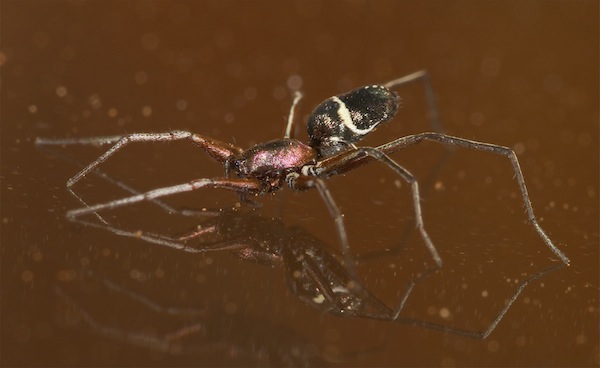
Kgalagadi Transfrontier Park
Description
Micaria is a gnaphosid although very atypical of the family. Unlike most Gnaphosids, they hunt during the day time.
PER (posterior eye row) is rarely procurved, usually straight. PME (posterior median eyes) irregularly shaped being oval or oblong
Spinnerets cylindrical (although they are not wide apart like other gnaphosids)
Carapace standard pear-shape
Abdomen covered (or partly so) with translucent iridescent scales and color pattern often, though not always, includes chevron-shapes.
3 species described from South Africa: Micaria beaufortia (Western Cape) and M. chrysis / M. tersissima from Northern Cape, Namaqualand (which might be the same species).
Micaria beaufortia
Male
Total length 4.35 mm. Carapace dark brown with blackish radial stripes, fovea short, almost indistinct, covered with short white hairs. Chelicerae, labium, maxillae and sternum light brown. All leg segments light brown. Abdomen dorsally dark grey with two white stripes, one transversal in middle part and another longitudinal behind it. Tarsi in all legs curved due to pseudosegmention (Ps). Metatarsus, tarsus of leg I, tarsi of leg II –IV with scopula.
Female
Total length 5.25 mm. Carapace light brown with blackish radial stripes, without fovea. Chelicerae, maxillae, sternum, labium as in males. Leg joints light brown except for femora, which are somewhat darker. Ventral parts of femora covered with short white hairs. Tarsi in all legs curved. Metatarsustarsus of legs I and II, tarsi of legs III and IV with scopula (the scopula more strongly developed than in males). Scopula formed by 2 pairs of rows of modified setae. Abdomen lighter than in male, grayish in anterior 1/3, with 2 transversal whitish stripes, posterior 2/3 blackish with median white stripe.
Distribution: Micaria beaufortia currently is known only from two localities in Western Cape, in Beaufort West (the type locality) and from environs of Worcester.
Links:
https://zenodo.org/record/832820#.Xr5ajUQzbIU
http://treatment.plazi.org/GgServer/htm ... F73C4CF83F
Family Gnaphosidae

Kgalagadi Transfrontier Park
Description
Micaria is a gnaphosid although very atypical of the family. Unlike most Gnaphosids, they hunt during the day time.
PER (posterior eye row) is rarely procurved, usually straight. PME (posterior median eyes) irregularly shaped being oval or oblong
Spinnerets cylindrical (although they are not wide apart like other gnaphosids)
Carapace standard pear-shape
Abdomen covered (or partly so) with translucent iridescent scales and color pattern often, though not always, includes chevron-shapes.
3 species described from South Africa: Micaria beaufortia (Western Cape) and M. chrysis / M. tersissima from Northern Cape, Namaqualand (which might be the same species).
Micaria beaufortia
Male
Total length 4.35 mm. Carapace dark brown with blackish radial stripes, fovea short, almost indistinct, covered with short white hairs. Chelicerae, labium, maxillae and sternum light brown. All leg segments light brown. Abdomen dorsally dark grey with two white stripes, one transversal in middle part and another longitudinal behind it. Tarsi in all legs curved due to pseudosegmention (Ps). Metatarsus, tarsus of leg I, tarsi of leg II –IV with scopula.
Female
Total length 5.25 mm. Carapace light brown with blackish radial stripes, without fovea. Chelicerae, maxillae, sternum, labium as in males. Leg joints light brown except for femora, which are somewhat darker. Ventral parts of femora covered with short white hairs. Tarsi in all legs curved. Metatarsustarsus of legs I and II, tarsi of legs III and IV with scopula (the scopula more strongly developed than in males). Scopula formed by 2 pairs of rows of modified setae. Abdomen lighter than in male, grayish in anterior 1/3, with 2 transversal whitish stripes, posterior 2/3 blackish with median white stripe.
Distribution: Micaria beaufortia currently is known only from two localities in Western Cape, in Beaufort West (the type locality) and from environs of Worcester.
Links:
https://zenodo.org/record/832820#.Xr5ajUQzbIU
http://treatment.plazi.org/GgServer/htm ... F73C4CF83F
Salticidae (Jumping Spiders)
Jumping Spiders. Family: Salticidae
The family Salticidae is the largest spider family, with more than 5000 species. They are distributed worldwide. The Afrotropical Region has a rich fauna, with 102 known genera, while from Southern Africa, 71 genera and about 300 species are known. South Africa has 46 genera.
The family name is derived from the Latin "salto" which means to dance with pantomimic gestures.
These spiders are harmless to man although there have been complaints where this comical, engaging animal has been accused of nasty bites.
Life style
Wanderers (ground and plant dwellers): diurnal cursorial hunting spiders with well developed vision.
Body size
3-17 mm. The Cape species rarely exceed 10 mm.
Diagnostic characters
Generally, they are squat-bodied with short legs but there are some species that are slender where they mimic certain insects. The integument (skin) varies from glabrous (hairless) to hirsute (hairy). Depending on the spider species and the animal that is being mimicked, they are often cryptically or attractively patterned.
The male is usually more slender and often looks totally different (sexually dimorphic) in shape and colour.
Colour: sometimes with bright attractive colouration consisting of bands, stripes or speckles and clothed with numerous special iridescent hairs.
Carapace: square-fronted with the length varying from short to elongated and the cephalic region high in some genera and eye region frequently decorated with clusters of long setae on the side.
Eyes: 8 in 3 rows or 4 occupying the whole width of the carapace, the anterior median eyes are characteristic in being very large. These binocular, telescopic eyes can identify detail and colour for up to 20 body-lengths making the spider a very successful hunter. The 6 other eyes detect movement and prey. The 2 wide-angled secondary eyes detect object up to 30-40cms. At about 20cms it turns to face the object, at 8-10cms is able to identify, at 3-4cms it will start to stalk and at 1-2cms the attack is launched.
Abdomen: variable from short to oblong to elongate in some genera.
Legs: legs rather short with anterior pair in some genera longer or stronger than other legs, frequently decorated with tufts of setae. The legs are not especially muscled for jumping but instead a jump is propelled by an explosive release of hydraulic pressure in the 4 hind legs. Unlike web-bound spider that have 3 claws, the salticids have 2 claws plus a scopulae pad (tuft of hair) that enables to adhere to various surfaces.
Web and retreat
Web: absent; retreat: they build nests in which they moult, oviposit and sometimes mate or which they occupy during periods of inactivity.
Habitat
They are found in a very wide habitat range and have been recorded from all the different biomes. They are also very commonly found in agro-ecosystems especially in orchards.
Behaviour
Salticids are usually diurnal, cursorial hunting spiders with well-developed vision. With their large eyes and complex retinas they have unique resolution abilities unparalleled in animals of similar size. The anterior median eyes allow them to discriminate between objects e.g. prey or mates. The smaller anterior lateral eyes detect
movement and help the spider to orientate to objects. Prey is detected and pursued by a combination of stalking, chasing, leaping or lunging. They are divided in three groups, hoppers, intermediates and runners. The various species either walk or jump but the salticids are the bungee jumpers of the spider world. To catch flying prey, they simply attach silk to a substrate and leap into the air. Should they miss a landing site, they simply haul themselves back up the launch site and reuse the bungee.
They have very diverse preying habits and are known to be able to leap or walk into webs of other spiders.
Courtship
Interesting and amusing studies have been done on mating dances carried out by male spiders which consist of ostentacious and ridiculous weaving and lurching accompanied by waving and signalling with the palps. The antics are sometimes mimicked by the females perhaps as a signal to the male that she has got into the swing of things and is available to mate. Some of the males' repetitive palp movements are thought to mesmerise or hypnotize the female, reducing the risk of attack. The courting male jumping spider must dance before his mistress and it seems that the male makes desperate attempts to impress the female with his dancing repertoire while the female follows every step with critical interest.
Links: Atlas of the Spiders of South Africa; Biodiversity Explorer; A pictorial index to the Afrotropical Salticidae; New data on the jumping spiders of South Africa (Araneae: Salticidae). Wanda Wesołowska1 and Charles R. Haddad2
The family Salticidae is the largest spider family, with more than 5000 species. They are distributed worldwide. The Afrotropical Region has a rich fauna, with 102 known genera, while from Southern Africa, 71 genera and about 300 species are known. South Africa has 46 genera.
The family name is derived from the Latin "salto" which means to dance with pantomimic gestures.
These spiders are harmless to man although there have been complaints where this comical, engaging animal has been accused of nasty bites.
Life style
Wanderers (ground and plant dwellers): diurnal cursorial hunting spiders with well developed vision.
Body size
3-17 mm. The Cape species rarely exceed 10 mm.
Diagnostic characters
Generally, they are squat-bodied with short legs but there are some species that are slender where they mimic certain insects. The integument (skin) varies from glabrous (hairless) to hirsute (hairy). Depending on the spider species and the animal that is being mimicked, they are often cryptically or attractively patterned.
The male is usually more slender and often looks totally different (sexually dimorphic) in shape and colour.
Colour: sometimes with bright attractive colouration consisting of bands, stripes or speckles and clothed with numerous special iridescent hairs.
Carapace: square-fronted with the length varying from short to elongated and the cephalic region high in some genera and eye region frequently decorated with clusters of long setae on the side.
Eyes: 8 in 3 rows or 4 occupying the whole width of the carapace, the anterior median eyes are characteristic in being very large. These binocular, telescopic eyes can identify detail and colour for up to 20 body-lengths making the spider a very successful hunter. The 6 other eyes detect movement and prey. The 2 wide-angled secondary eyes detect object up to 30-40cms. At about 20cms it turns to face the object, at 8-10cms is able to identify, at 3-4cms it will start to stalk and at 1-2cms the attack is launched.
Abdomen: variable from short to oblong to elongate in some genera.
Legs: legs rather short with anterior pair in some genera longer or stronger than other legs, frequently decorated with tufts of setae. The legs are not especially muscled for jumping but instead a jump is propelled by an explosive release of hydraulic pressure in the 4 hind legs. Unlike web-bound spider that have 3 claws, the salticids have 2 claws plus a scopulae pad (tuft of hair) that enables to adhere to various surfaces.
Web and retreat
Web: absent; retreat: they build nests in which they moult, oviposit and sometimes mate or which they occupy during periods of inactivity.
Habitat
They are found in a very wide habitat range and have been recorded from all the different biomes. They are also very commonly found in agro-ecosystems especially in orchards.
Behaviour
Salticids are usually diurnal, cursorial hunting spiders with well-developed vision. With their large eyes and complex retinas they have unique resolution abilities unparalleled in animals of similar size. The anterior median eyes allow them to discriminate between objects e.g. prey or mates. The smaller anterior lateral eyes detect
movement and help the spider to orientate to objects. Prey is detected and pursued by a combination of stalking, chasing, leaping or lunging. They are divided in three groups, hoppers, intermediates and runners. The various species either walk or jump but the salticids are the bungee jumpers of the spider world. To catch flying prey, they simply attach silk to a substrate and leap into the air. Should they miss a landing site, they simply haul themselves back up the launch site and reuse the bungee.
They have very diverse preying habits and are known to be able to leap or walk into webs of other spiders.
Courtship
Interesting and amusing studies have been done on mating dances carried out by male spiders which consist of ostentacious and ridiculous weaving and lurching accompanied by waving and signalling with the palps. The antics are sometimes mimicked by the females perhaps as a signal to the male that she has got into the swing of things and is available to mate. Some of the males' repetitive palp movements are thought to mesmerise or hypnotize the female, reducing the risk of attack. The courting male jumping spider must dance before his mistress and it seems that the male makes desperate attempts to impress the female with his dancing repertoire while the female follows every step with critical interest.
Links: Atlas of the Spiders of South Africa; Biodiversity Explorer; A pictorial index to the Afrotropical Salticidae; New data on the jumping spiders of South Africa (Araneae: Salticidae). Wanda Wesołowska1 and Charles R. Haddad2
Salticidae, Genus Heliophanus
Genus Heliophanus
Heliophanus is a large genus that includes more than 100 species in the Palaearctic and Afrotropical regions, as well as a single Oriental species. These spiders are dark brown to black in colour, often with a metallic sheen. The shortish, stocky legs are often lighter in colour, sometimes being bright yellow. The pedipalps of females are usually light coloured and sometimes even bright yellow. There is often a white narrow band running along the anterior edge of the abomen and often two smallish white spots set transversely across the abdomen near the spinnerets. The cephalothorax is moderately high and, in plan, is an elongate, broad oval, widest towards the rear and slightly truncated at the front. The stoutish abdomen is also elongated, broad oval, rounded anteriorly and somewhat tapering posteriorly. The spinnerets are small and located at the extreme tip of the abdomen. There are a few spines on the legs. Characteristic of most males of Heliophanus are the large femoral apophyses on the palps.
From South Africa are 42 species reported.
Males in subgenus Helafricanus are black with a metallic shine and white markings, while females are often mottled brown and grey in colour, with a lighter median abdominal stripe. The males in this subgenus have a large patellar apophysis and small femoral protuberance, while females have seminal ducts directed anteriorly and spermathecae that tend to be coiled.
Males of the subgenus Heliophanus can be recognized by the large femoral apophysis and additional femoral protuberances, and females by the presence of a single large or two small copulatory openings. Members of this subgenus are not sexually dimorphic, and colouration is similar in both sexes.
Links:
http://rcin.org.pl/Content/57921/WA058_ ... l-Nr-1.pdf
Heliophanus is a large genus that includes more than 100 species in the Palaearctic and Afrotropical regions, as well as a single Oriental species. These spiders are dark brown to black in colour, often with a metallic sheen. The shortish, stocky legs are often lighter in colour, sometimes being bright yellow. The pedipalps of females are usually light coloured and sometimes even bright yellow. There is often a white narrow band running along the anterior edge of the abomen and often two smallish white spots set transversely across the abdomen near the spinnerets. The cephalothorax is moderately high and, in plan, is an elongate, broad oval, widest towards the rear and slightly truncated at the front. The stoutish abdomen is also elongated, broad oval, rounded anteriorly and somewhat tapering posteriorly. The spinnerets are small and located at the extreme tip of the abdomen. There are a few spines on the legs. Characteristic of most males of Heliophanus are the large femoral apophyses on the palps.
From South Africa are 42 species reported.
Males in subgenus Helafricanus are black with a metallic shine and white markings, while females are often mottled brown and grey in colour, with a lighter median abdominal stripe. The males in this subgenus have a large patellar apophysis and small femoral protuberance, while females have seminal ducts directed anteriorly and spermathecae that tend to be coiled.
Males of the subgenus Heliophanus can be recognized by the large femoral apophysis and additional femoral protuberances, and females by the presence of a single large or two small copulatory openings. Members of this subgenus are not sexually dimorphic, and colouration is similar in both sexes.
Links:
http://rcin.org.pl/Content/57921/WA058_ ... l-Nr-1.pdf
AW Arachnid Book: Spiders (Araneae) - Photos & Descriptions
Jumping Spider Heliophanus sp.
Family Salticidae
 © BluTuna
© BluTuna
Female. Garden in Johannesburg
Family Salticidae
 © BluTuna
© BluTunaFemale. Garden in Johannesburg
Hunting cannot be considered a sport as all contestants in a sport should know they are playing the game!


